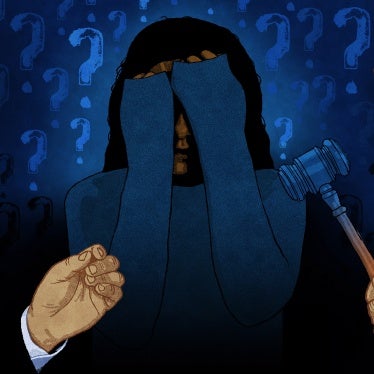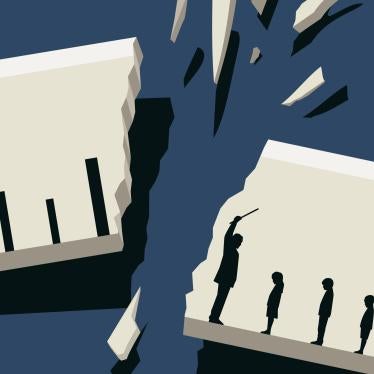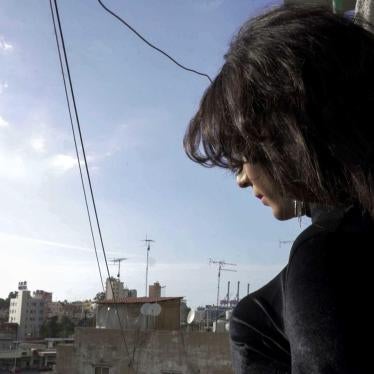On October 16, the U.S. Department of Justice opened an investigation of the Baltimore City Detention Center to examine possible violations of the constitutional rights of inmates. The investigation will focus on unsafe living conditions, inadequate medical care (including mental health care), inadequate protection from harm for all inmates, and excessive use of isolation for the juvenile population.
The investigation was prompted in part by a November 1999 Human Rights Watch report on conditions for children in Maryland jails. The 169-page report, No Minor Matter: Children in Maryland's Jails examined conditions in the Baltimore City Detention Center, as well as jails in Frederick, Montgomery, Prince George's, and Washington counties. One of the report's recommendations urged the Department of Justice's Civil Rights Division to investigate conditions of confinement for children detained in Maryland's jails.
Summary of Human Rights Watch's Findings at the Baltimore City Detention Center:
Over 100 juveniles are in detention in the Baltimore City Detention Center on any given day — representing one-half to two-thirds of all children held in adult jails in the state. The jail is a crumbling, century-old facility, where juveniles are confined to dimly lit, squalid cells crawling with cockroaches and rodents and subject to extreme temperatures. Violence between inmates is rampant and often involves crude "shanks," made from pieces of metal from air vents or old light fixtures. Some jail guards have condoned and even organized fights between youth, known as "square dances," which have resulted in serious fights. Youth at the jail are frequently confined to their cells for lengthy "lockdown" periods, and may be subject to disciplinary isolation for ninety days or more for relatively minor infractions.
Specific Findings:
Living Conditions
With portions of its Men's Detention Center dating to 1809, the Baltimore City Detention Center is the oldest pretrial facility in use in the state of Maryland. LaMont Flanagan, commissioner of the state Department of Public Safety and Correctional Services' Division of Pretrial Detention and Services, referred to the jail as an "artifact" and described the facility as "your old style jail that you see on television."
Over 100 youth under the age of eighteen are held in this crumbling facility, which is equipped with woefully inadequate light and ventilation and infested with vermin. The vast majority of detainees are male, with no more than five to ten girls in detention at any one time.
The average length of stay for juveniles is 113 days, according to the Division of Pretrial Detention and Services' figures for fiscal year 1999. Many remain in detention for six months or more.
Bars along the front of each row of cells open onto a passageway; no cell faces any other cell. Exposed pipes, many with torn insulation, line the passageways. The only natural lighting in the section comes from the four or five large windows in each passageway. At the time of our visit in May 1999, most of these windows were partially blocked by plywood or covered by opaque plexiglass or translucent plastic sheeting. Most of the glass panes were broken where the windows were not covered.
Originally designed for single occupancy, most of the cells have two bunks and a combination sink and toilet. The majority of the cells measure about eight by seven feet and have eight-and-a-half-foot ceilings; two cells, the first on each side of the upper tier, are slightly larger. The section has two isolation cells with heavy metal sheets completely covering the bars, blocking all natural light from entering the cells.
Violence
Weapons are widespread at the Baltimore city jail. Because of the facility's age, detainees are readily able to make "shanks," or weapons fashioned from pieces of metal from air vents or old light fixtures. One detainee told Human Rights Watch: "The whole section has knives. People got to keep them for a reason, because they fear for their life. If you feel you're gonna get stabbed up and the CO's not gonna do nothin, you got to take matters into your own hands."
Although the jail reports that incidents of violence have declined over the past five years, it remains unacceptably high. During our May 1999 visit to the jail, we reviewed all special incident reports involving juveniles that had been filed within the previous nine months. The reports documented a total of thirty-five incidents, including twelve assaults or stabbings. When we asked an official about juvenile-on-juvenile violence in the jail, he said, "There's something maybe once, twice a week. It's difficult to assess unless they tell us they have an enemy."
Many juvenile detainees reported that violence and harassment was a regular occurrence. Joey, seventeen, described the degrading harassment he endured from the adult inmates in the segregation section of the Baltimore detention center:
"Every day, the other inmates, they would throw stuff at me. You know, like shit and stuff. I complained to the CO's, but they didn't do nothing. I can't count the number of times I asked the CO's to move me. I said, "Can you move my cell?" They said no, but they seen the shit. Every day I'm getting shit thrown on me from the others cells. I didn't want to say nothing out loud directly, because the other guys would just keep doing it. I just kept asking to get moved."
In desperation, Joey finally resorted to telling the guards he was suicidal so that he would be moved to a special area for those on suicide watch.
Human Rights Watch heard several accounts that guards allowed youths to fight with each other in a practice known as the "square dance." Detainees told us that during the "dance," guards lock all detainees into their cells, except for two boys who fight in a square area on the tier, measuring about eight feet by eight feet. Guards supply those fighting with boxing gloves, and monitor the fight. Jackson reported:
"It ends up with busted heads, slashes over your eyes, broken fingers, cut lips, maybe a broken nose. But you don't go to the hospital for the cuts. If you did, there'd have to be a report, and the guards would have to explain why two guys were out in the square while everybody else was locked in."
Discipline
Juvenile detainees at the Baltimore detention center frequently reported arbitrary and excessive punishment. Our review of disciplinary records in that jail found many instances in which children were given lengthy periods of segregation, often with loss of visits and other privileges, for relatively minor offenses. One youth threatened another for his sweatpants and received ninety days of segregation with loss of privileges. Another received forty-five days after throwing a bar of soap at a guard and telling him to get off the tier. A third received sixty days with loss of privileges after refusing to go into his cell when ordered and reportedly becoming belligerent toward the staff.
In many more serious cases, we found that disciplinary hearing officers routinely gave juveniles the maximum sanction possible — ninety days in segregation per charge — and in some cases directed youth to serve their sanctions consecutively.
Those sent to segregation are confined to their cells for twenty-three hours a day. Child and adolescent psychiatrists have concluded that such isolation over extended periods is the equivalent of sensory deprivation, and can create extraordinarily severe psychic stress for adolescents.
Some youth are placed in administrative detention for the entire period of their pretrial detention, a status known as "supermax." Such placement is often made without a hearing, and can be based solely on a notation that jail staff suspect that the youth posed a safety risk. American Correctional Association (ACA) standards permit the use of disciplinary segregation only after an impartial hearing has determined that alternative dispositions are inadequate and that the inmate's presence in the general population poses a serious threat to security or operations.
The ACA standards applicable to juvenile detention facilities call for no more than five days of such confinement. Even for adults, these periods of segregation are excessive. ACA standards applicable to adult jails call for a sixty-day maximum on disciplinary segregation for all violations arising out of one incident, and call for a review by the facility administrator for any confinement exceeding thirty days.
Youth at the Baltimore City Jail are also frequently subjected to lockdowns, meaning that they are restricted to their cells with limited or no access to showers, recreation, visitation, or religious services. After an escape or fight, entire sections, and sometimes the whole facility can be locked down for days or even weeks. "We go on lock a lot," reported Paul. "Can't come out of your cell, no showers, no phone calls." The general population had been on lockdown for much of the six months preceding Human Rights Watch's May 1999 visit. The application of such broad restrictions for lengthy periods of time appears at best to be arbitrary, lacking any valid security rationale; at worst, such practices constitute collective punishment, which is prohibited under international standards.
Medical and Mental Health Care
The Baltimore City Detention Center has procedures in place to examine detainees upon their admission, and all of the youth we interviewed reported that they were screened by medical staff within several days of their arrival.
Nevertheless, youth frequently told us that they had difficulty seeing medical staff when they were sick or needed dental care. "You got to write a lot of times," said Joey. Marlow, a sixteen-year-old at the city jail, told us, "I put out a sick call, but not been called yet. That was three weeks ago." In general, youth reported that they would have to wait a week or more to see a nurse or doctor if they became sick after receiving their initial medical examination; some youth reported that their requests for medical assistance were ignored altogether.
In Maryland and across the United States, detainees have a higher incidence of mental illness than the population as a whole. Accordingly, mental health services are a critical aspect of medical care in jails. In our tour of the Baltimore City Detention Center, where Human Rights Watch's investigative team included a mental health professional, we were disturbed to find serious deficiencies in the mental health program.
Mental health services in Baltimore's jail are minimal to nonexistent, with no services especially for juveniles. There are no therapeutic groups, no individual counseling, and no efforts at aftercare planning. In practice, the only detainees who receive mental health services are those in crisis, who are housed in deplorable conditions. Touring the mental health unit, we saw inmates who were naked, with nothing more than paper blankets to cover their bodies; no medical necessity justified this dehumanizing practice.
The lack of appropriate mental health care is especially troubling because children in detention are much more likely than youth as a whole to have mental health needs, and the conditions in which they are confined may well exacerbate their preexisting mental disabilities. Even for those youth who do not come to jail with prior mental health needs, being jailed takes an emotional toll. Indeed, research suggests that children in adult jails may be up to eight times more likely to commit suicide than their peers held in juvenile detention centers.
Girls in Detention
Girls in detention are faced with the prospect of near-total isolation, often left only with each other for company. Human Rights Watch investigators touring Baltimore's jail saw the two girls then in detention standing at the door to their section, their faces pressed to the window and schoolbooks clutched in their arms. When we entered the section, they demanded to know when somebody would come to take them to school, telling us that they had not been to classes for three days. They reported that they rarely had contact with guards apart from meals and the times they were taken to and from school. "We thought maybe they forgot about us," one said.
Girls are usually housed in Dormitory M in the Women's Detention Center. No adults are housed with the juveniles in this dormitory, and detention center officials repeatedly characterized the housing for juveniles as "sight and sound separation" from adults. Nevertheless, women are housed in the next dormitory and could be clearly heard from the girls' dormitory by our researchers. The corrections officer who escorted the Human Rights Watch representatives touring this area conceded, "Well, the female juveniles really can hear the adults. They just can't see them." Even that description was not quite accurate, as girls must walk by three or four adult dormitories, each with floor to ceiling bars along the front, every time they go to or from school, receive visits, take recreation outside their dormitory, or go to the clinic. The officer stated, however, that all adults were locked in their dorms any time a juvenile was in the hallway outside the girls' dormitory.
Girls placed in administrative segregation, usually as the result of a disciplinary infraction, are housed in the women's segregation area, although they do not share cells with women detainees. The guard on duty at the section informed us that detainees in segregation are only allowed attorney visits and receive no commissary privileges. Asked how much time each detainee was able to spend outside her cell, the guard replied, "They're outside enough to take a shower and clean their rooms, maybe fifteen to twenty minutes in total. It's two showers a week." Those on "supermax" status—meaning that they spend their entire period of pretrial detention on this section—are allowed outside their cells for a total of one hour each day. The officer told us that supermax detainees may receive visits and make telephone calls. When we pointed out that there was no telephone in the section, our escort explained that inmates could place phone calls through the chaplain's office.







